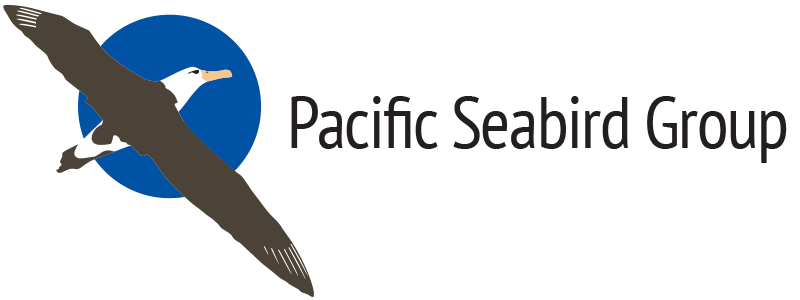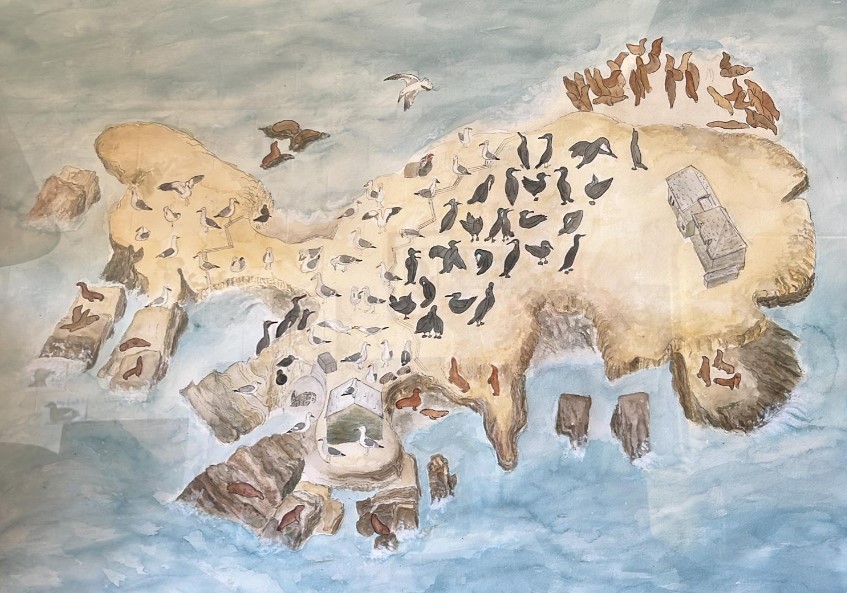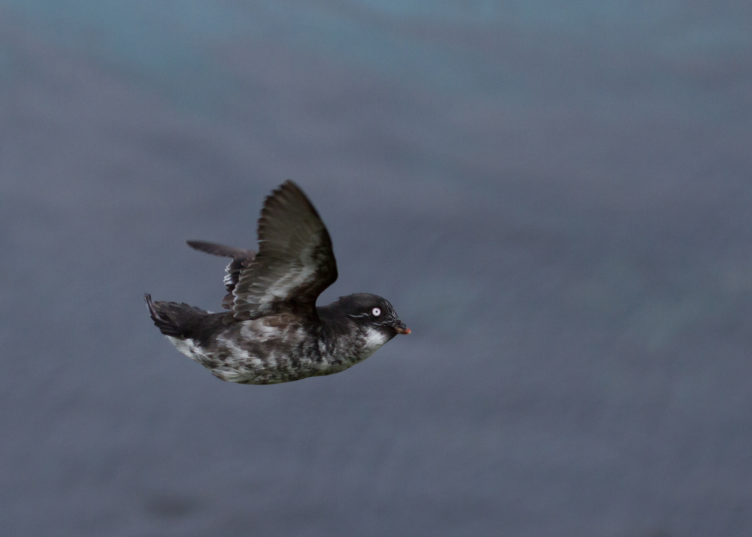Oikonos teams with scientific illustrators to highlight breeding seabirds at Año Nuevo Island, California
By Oikonos
Conservation invites people from all walks of life to collaborate and discover innovative solutions for pressing environmental challenges. In the coastal town of Santa Cruz, California, four remarkable artists—Lizzie Schafer, Constance Speer, Hannah Kanne, and Bridget Bailey—have chosen to help nature through scientific illustration, demonstrating that there’s more than one avenue to promote conservation!
Art serves as a powerful medium for science communication in numerous ways. It transcends language barriers, raises awareness about environmental issues, and renders complex scientific ideas understandable. Art is not merely science’s whimsical sidekick, but an indispensable tool for communicating scientific knowledge.
Año Nuevo Island is a 9-acre island located between San Francisco and Santa Cruz in central California. Adjacent to Monterey Bay and just one kilometer offshore, Año Nuevo Island’s location offers over 10,000 breeding seabirds access to both nearshore resources and nearby submarine canyon feeding hotspots. Historically, lighthouse operations and unrestricted public access disturbed the wildlife population on the island. Today, the island is protected as part of the Año Nuevo State Reserve and closed to the public to protect breeding seabirds and marine mammals.
Seven breeding seabirds have been researched at Año Nuevo Island annually for the past 30 years. Point Blue Conservation Science initiated the project in the 1990s, and Oikonos Ecosystem Knowledge has led this project for the past 15 years. The project has expanded in scope over the years, incorporating working with artists and designers to create interdisciplinary habitat restoration to sustain the island’s seabird species, including an innovative sea lion exclusion structure to prevent damage to auklet nesting burrows and new ceramic artificial nest designs for auklets.
In 2023, Oikonos invited scientific illustrators to join researchers on the island to completely immerse themselves in the ecological marvels of Año Nuevo Island. Artists Lizzie, Constance, Bridget, and Hannah embarked on a creative and adventurous journey, boating across to the island in an inflatable zodiac and spending several days and nights drawing the island inhabitants from real life. Each artist later produced final pieces highlighting seabird ecology at the breeding colony through their unique styles and perspectives.
These art pieces were displayed in July at an exhibition hosted at the Seymour Center Marine Discovery Center in Santa Cruz, bringing the wonders of the seabird breeding colony to the local community. Below, the artists speak to their experiences on the island and share their final art pieces.
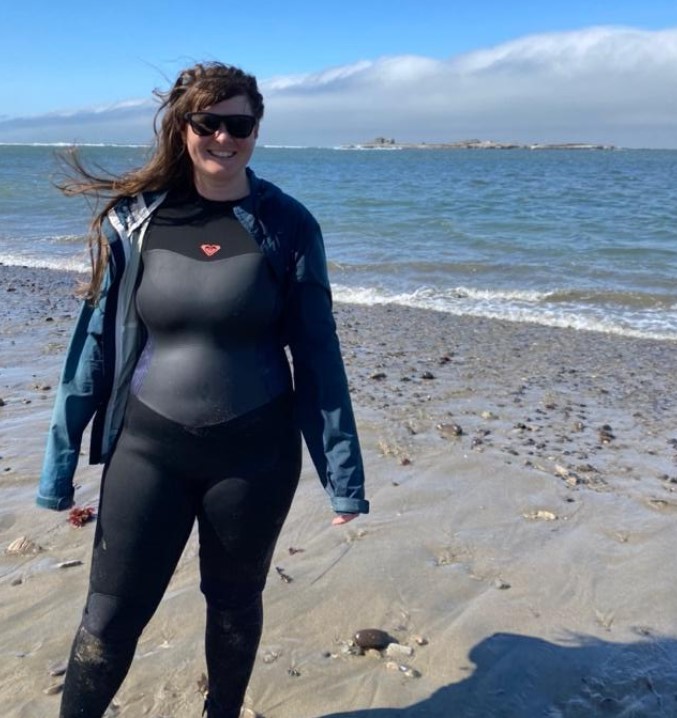
Bridget Bailey
Bridget graduated from California State University, Monterey Bay (CSUMB) with a certificate in scientific illustration in 2022 and has been working as a freelance scientific illustrator and designer since.
“Nature has often inspired my art, and I think that by working in collaboration with the science community, art can inspire engagement with the natural world and encourage further action to conserve it.”
Bridget’s experience at Año Nuevo Island
“It was exhilarating to land on an island I’d never been to and come face-to-face with a bird that was also completely new to me, the Pigeon Guillemot. […] The best experience for me was getting to see a Cassin’s Auklet chick! The opportunity to see the methods used to research seabird chicks was truly eye-opening for me.”
“I learned that if I stayed quiet and still, the gulls and cormorants would let me make sketches that captured their behavior, interactions, and even how they build nests.”
The first of Bridget’s pieces is a detailed ink rendition of a Western Gull nest, highlighting the beautiful chaos of a nest with various nesting materials gathered on the island. The second of Bridget’s pieces is a gouache landscape of the islands’ cliffs, featuring Brandt’s Cormorants, California Brown Pelicans, Northern Elephant Seals, and Western Gulls interacting with the beautiful yet harsh coastal environment.
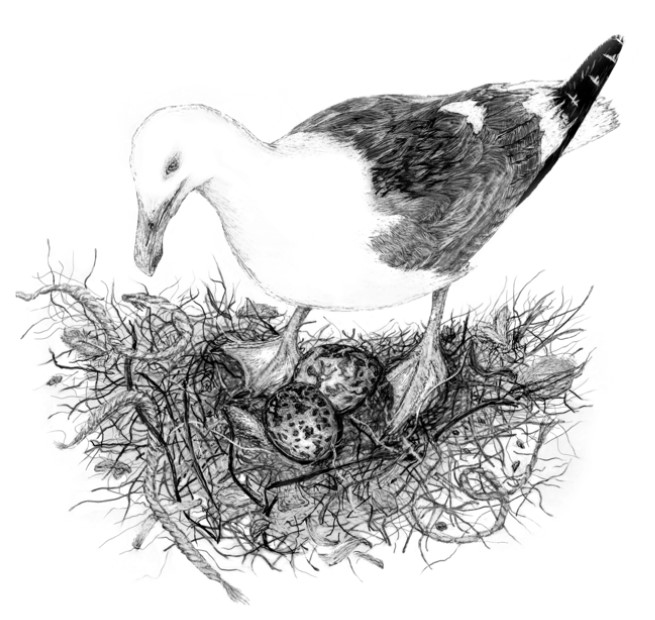

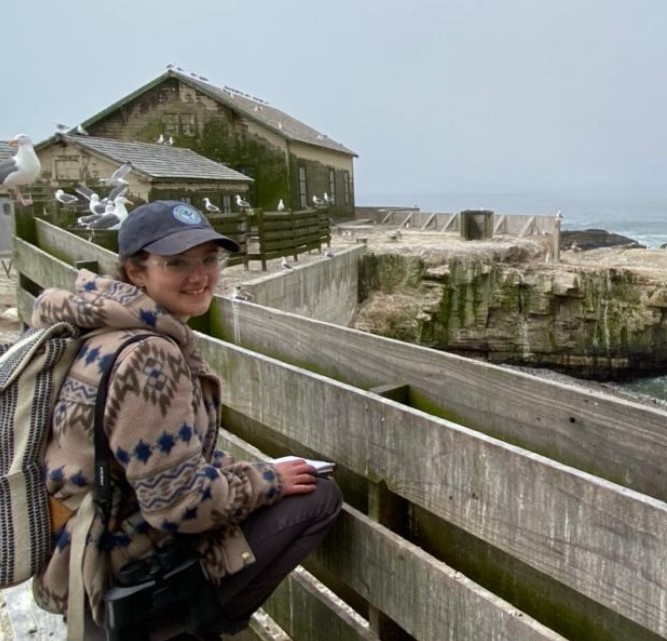
Lizzie Schafer
Lizzie has a long history with painting and began exploring natural history illustration during the University of California Santa Cruz’s (UCSC) Natural History Field Quarter class. She is currently in her final year at UCSC studying Environmental Studies.
“Drawing is a way for me to appreciate nature more deeply, through looking closer at the physical forms and noticing things about a plant, animal, landscape that would have escaped my attention otherwise. […] Art for conservation and scientific purposes is still very much alive and needed!”
Lizzie’s experience at Año Nuevo Island
“Even though I knew that Año Nuevo Island would be covered with seabirds, it was hard to imagine before getting there just what that would look like. The density of wildlife was unlike pretty much anything else I had ever seen. Seals and sea lions were piled on the beach and outer terraces, but on most of the island it was birds everywhere—flying, squawking, mating, nesting, roosting, fighting. Any space that wasn’t occupied by seabirds had been trampled bare of any plant life, and the smell of guano was everywhere. The more I looked, the more questions I had about each species’ behaviors, distributions on the island, and life histories when they leave the island. I felt inspired and giddy walking around, sketching as fast as I could. I was especially fascinated with the Brandt’s Cormorants breeding behaviors. When a mate returned to a nest with nesting material, the pair would circle and sway their necks, and nibble at each other’s mouths together in a dance. Eventually, they would place it together. It reminded me of dancing and cuddling, and I couldn’t help but think of it as loving.”
Lizzie’s first illustration highlights the various “billing” movements between a pair of Brandt’s Cormorants, common in courtship behavior between mates at the nest. Lizzie used her second piece to create a “treasure map,” detailing the spatial segregation of species on the island and including buildings (in use and abandoned).
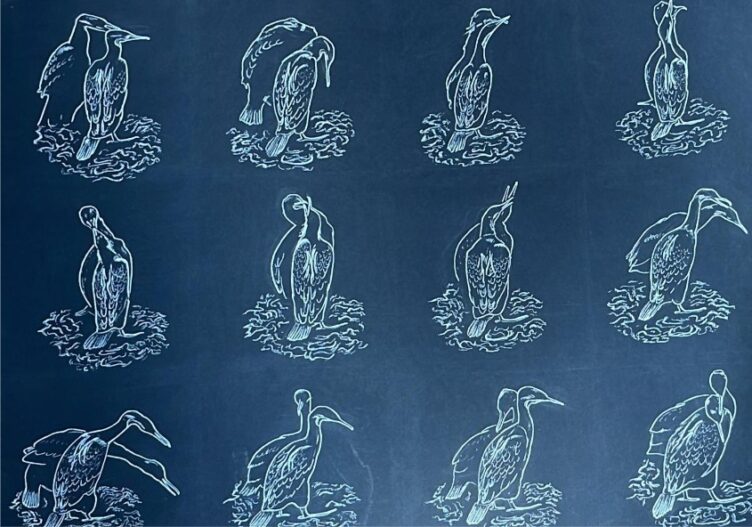

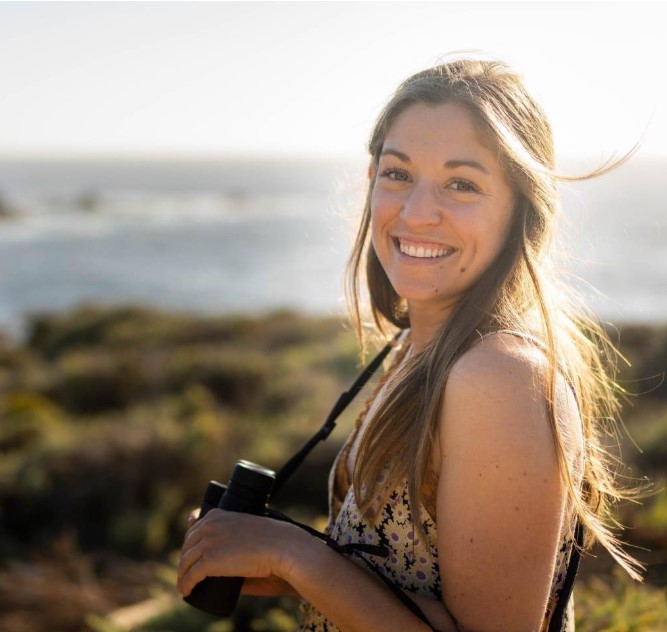
Constance Speer
Constance received her certificate in Science Illustration from CSUMB, where she discovered her love for natural history illustration. She hopes that her illustrations serve as a reminder of the beauty found in moments of tranquil observation.
“I was always torn between art and a passion for the outdoors. In undergrad I studied art, but I spent most weekends camping with the Outdoor Recreation department. I became curious about the history of the plants and animals around me. When I discovered the field of science illustration, I knew it was the perfect match for me. Finally, I had the opportunity to learn more about nature, while developing my art practice.”
Constance’s experience at Año Nuevo Island
“It was amazing to be surrounded by untamed wildlife and observe research in action. Before this trip I had never seen a Western Gull’s eggs. During my visit to the island, I saw not only Western Gull eggs, but I had the opportunity to peer into a Rhinoceros Auklet’s burrow through a research camera. Observing these seabirds in their natural habitat allows me to better understand the birds’ anatomy and behavior.”
Constance’s illustration depicts a tranquil scene on the island with Brandt’s Cormorants, Western Gulls, and Black Oystercatchers congregating on the cliffs, illuminated by sunlight peeking through a dark sky. She also highlighted some of the habitat restoration used on the island to protect burrow and surface nesting seabirds, including a ceramic nesting module and a fence line that excludes pinnipeds to protect the main seabird breeding area on the island.
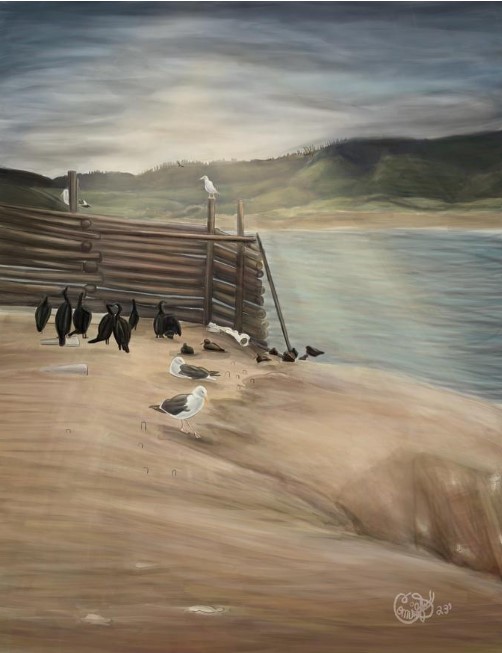
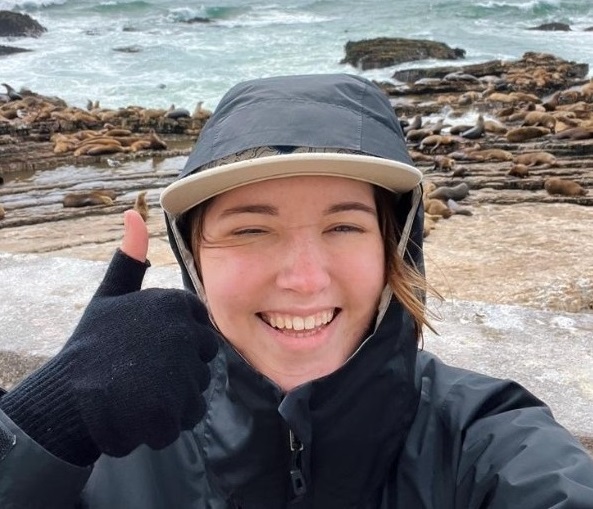
Hannah Kanne
Hannah received her B.F.A. in Studio Art with an emphasis on Scientific Illustration, and later received her certificate in Scientific illustration from CSUMB.
“It all started when I was little, watching Steve Irwin and his passion for nature and animals. His passion influenced me, and I hope to do the same for others through my art by highlighting the beauty and complexity of our ecosystems.”
“The few days I was able to spend on the island were incredible. Being completely surrounded by seabirds and pinnipeds was a dream. I will never forget looking up at the sky during sunset and seeing hundreds of brown pelicans flying over me. Much of my time on the island was spent simply observing. Watching how the seabirds interact with each other, how they interact with the sea lions and elephant seals, watching them with their mates as they return to the nest, and yell at anyone and anything that got too close to their nests. I would become so entranced by them and their silly little behaviors, that I would forget I was in the middle of a painting. I felt so honored to spend those few days in such a delicate and important space for each individual on Año Nuevo Island (even if one of them pooped on my camera).”
Hannah’s art focused on the highly variable nesting habits of the resident seabird species depicting burrowing Cassin’s and Rhinoceros Auklets, cliff-dwelling Pigeon Guillemots and Pelagic Cormorants, and others found around the island!
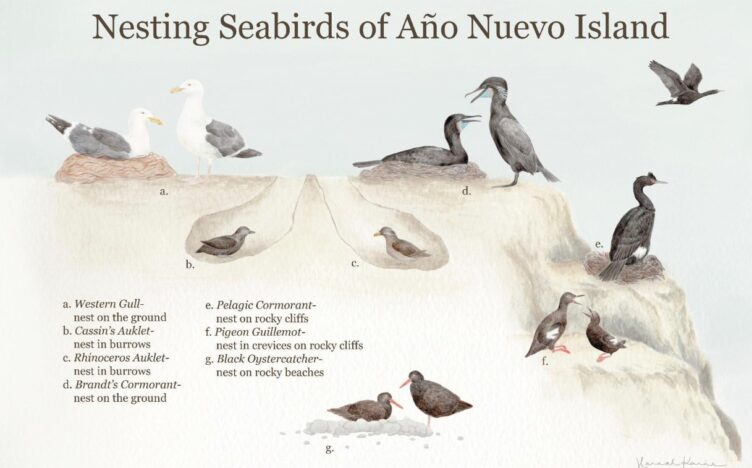
Art and science
These artworks serve as windows into the intricate world of seabird breeding behavior, fostering a connection between the local community and their natural heritage. This program by Oikonos strives to unite artists with their community while bridging the gap between the community and remote, inaccessible places.
Oikonos Ecosystem Knowledge has been a non-profit leader in science and community-driven conservation for over twenty years. Our mission is to study and protect imperiled ecosystems by engaging diverse communities through innovative scientific and artistic collaborations. Oikonos works throughout the Pacific with field offices in Hawaii, California, Washington, and Chile.
To learn more about Oikonos and habitat restoration and monitoring at Año Nuevo Island, visit us at www.oikonos.org or read our 2022 Año Nuevo Island Report.
